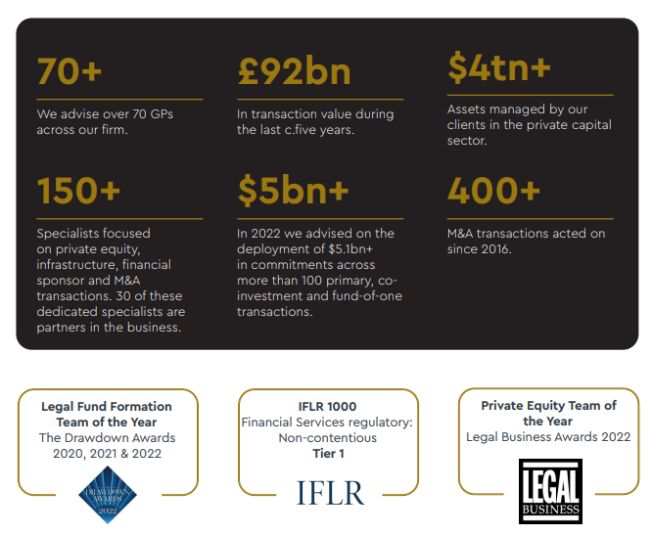The Institutional Limited Partners Association guidance on Continuation Funds ("CFs") landed last month and, whilst some of what they describe reflects the operation of well run processes already being undertaken, these guidelines seek to address "growing LP frustrations" and set out principles GPs and LPs should follow to reduce the perceived and actual misalignment of interests in deals which are, by their very nature, conflicted.
In this week's Talking. Secondaries. we set out some of the key points from the guidance which is intended to help encourage deal processes and structures which support the general principles that: (a) CF deals should maximise value for existing LPs; and (b) Rolling LPs should be no worse off than if the transaction had not occurred.
The guidance is in large part a codification of what a good GP-led transaction process looks like and in many ways reflects market practice. That said, some elements of it, e.g. allocation of transaction costs, interaction with the LPAC etc, may cause some GPs and finance advisors to think more carefully about how to bring existing LPs through a process.
Why has ILPA issued these guidelines now?
- CFs are more popular than ever before
- Increased capital and sophistication in the secondaries market means these transactions are here to stay
- Some LPs have expressed frustration at some aspects of CF deals and ILPA is looking to address those. These issues can be summarised as:

Demystifying the secondaries market
Part 4: New ILPA Guidelines on Continuation Funds
Deal economics
- 100% of accrued carry should be rolled into the CF and where not all carry is rolled, the GP should provide a detailed explanation as to why. For those funds with European waterfalls which are not yet in the carry, alignment will need to be sought by LPs via a higher GP commitment to the CF.
- Transaction costs should be split according to which of the stakeholders benefit from the transaction – specifically noting that where a GP "benefits" from a transaction, the GP should share a portion of costs. Costs associated with the CF establishment should be borne by the rolling LPs and any new investors.
- Management fee on a continuation vehicle should be proportionate to the operational requirements of managing the relevant assets.
- LPs should be offered a status quo option in the new structure with no change in economic terms (such terms to include no increase in management fee; no increase in carried interest). Furthermore, there should be no minimum required roll in order to access these "status quo" terms.
- Dilution of rolling LPs as a consequence of their election not to participate in follow-on capital should be done on a "fair and reasonable basis". GPs are also expected to explain to LPs why such dilution is accretive to the return on the transacted assets and guidance is provided as to the valuation metrics for such dilutive capital.
LPAC Involvement
- Early, regular and fulsome communication with the LPAC is the essence of ILPA's guidance. The advice that the LPAC (if it requests) should be provided with an independent advisor on the deal (at the Fund's expense) is perhaps at odds with current European practice but seems like a natural progression in a maturing market.
- ILPA go some way to articulate what the LPAC is not: it is not there to recommend the transaction to LPs (even if amendments to the selling fund's LPA is required as part of the transaction); and it does not owe a fiduciary duty to LPs. The LPAC though is there to: (a) provide a sounding board for GPs considering a CF deal and on
- whom the rationale can be tested before it is proposed more widely to the LPs; (b) approve conflicts related to the transaction; and (c) provide guidance to the GP to ensure a transparent and fair process.
- The LPAC should have sufficient information to ensure the process was structured appropriately to obtain a fair price. They should also review and approve any break fees in the event of an abort.
- ILPA has also said that conflict on CF deals should not be pre-approved in fund LPAs – the deals should be considered on a deal-by-deal basis.
Process Management
- Price should always be verified by a third party valuation and / or the sale of a minority interest to a third party purchaser.
- Whilst LPs should have at least 30 calendar days / 20 business days to review the election forms, ILPA has stressed the importance of giving LPs sufficient time to get through the various stages of review required in order to undergo the rollover process. GPs should try to give LPs more time where possible.
- Prior to finalising terms of the deal, ILPA have suggested that GPs should meet with the LPAC to discuss the rationale for the deal terms of the CF and the acquisition agreement. ILPA has specifically stated that this should be with the LPAC as the group – presumably in order to dissuade GPs from trying to pick-off LPAC members one-by-one.
- ILPA has also advised that LPs invited to roll should have access to the data room made available to new LPs coming into the CF so there is parity of information across the investor base.
- An LP should never be forced to roll – this feels commercially unlikely to occur in any event but ILPA has codified this.
- Existing side letters for rolling LPs should apply to the CF – either by way of a new side letter or pursuant to the terms of the LPA. Noting that not all side letter terms may be applicable, at a minimum all risk and governance terms should apply
Our secondaries platform
Travers Smith has extensive experience in complex private markets transactions, with a focus on liquidity solutions across the private markets capital structure with exposure across all asset classes.

Originally Published by 2 June 2023
The content of this article is intended to provide a general guide to the subject matter. Specialist advice should be sought about your specific circumstances.








